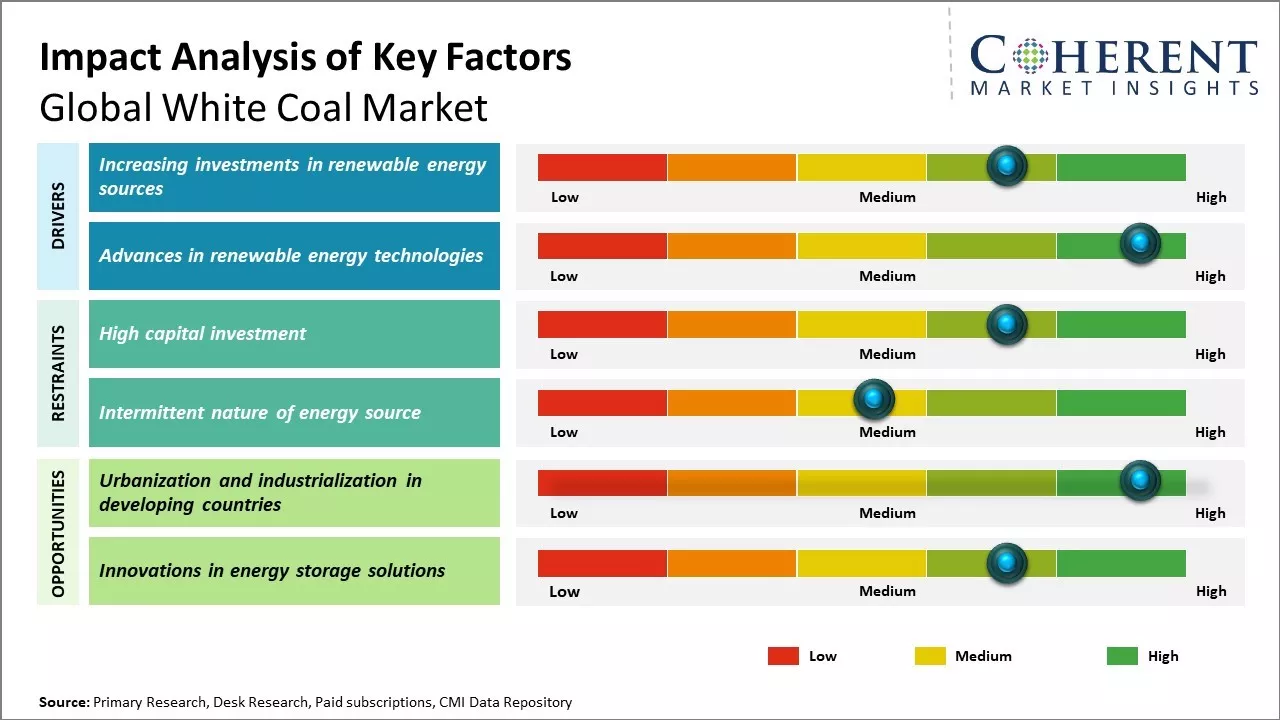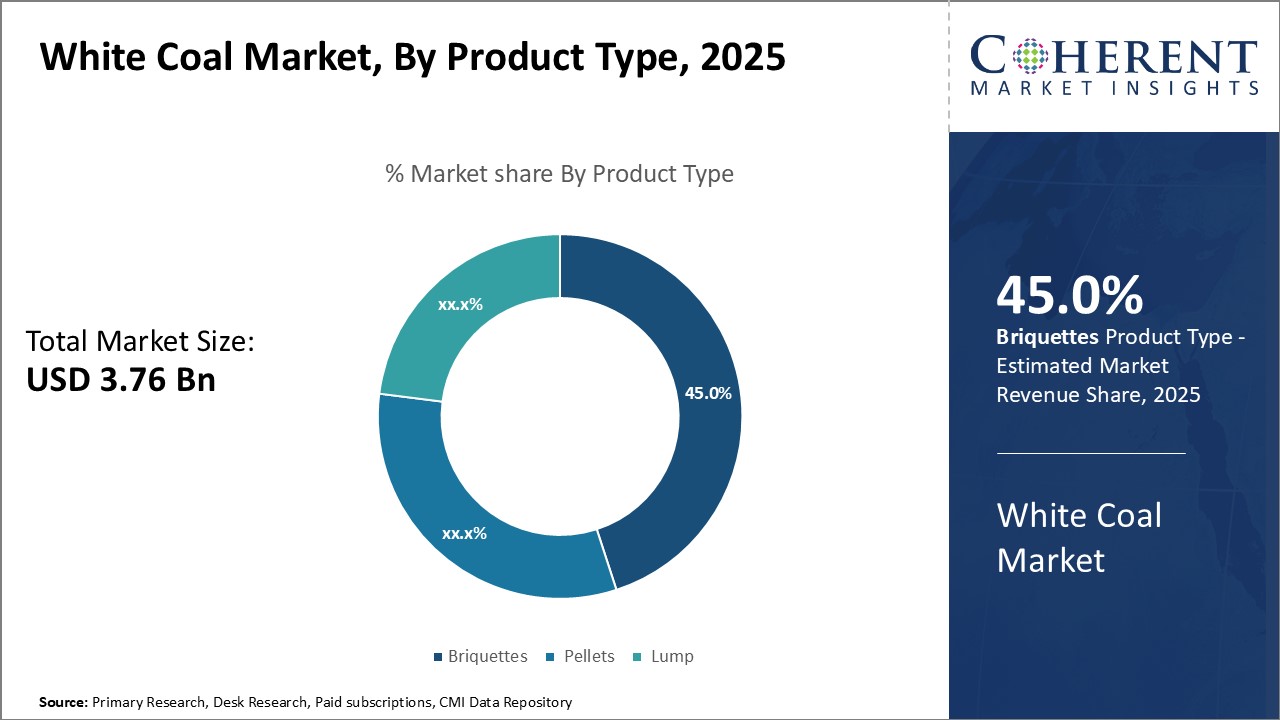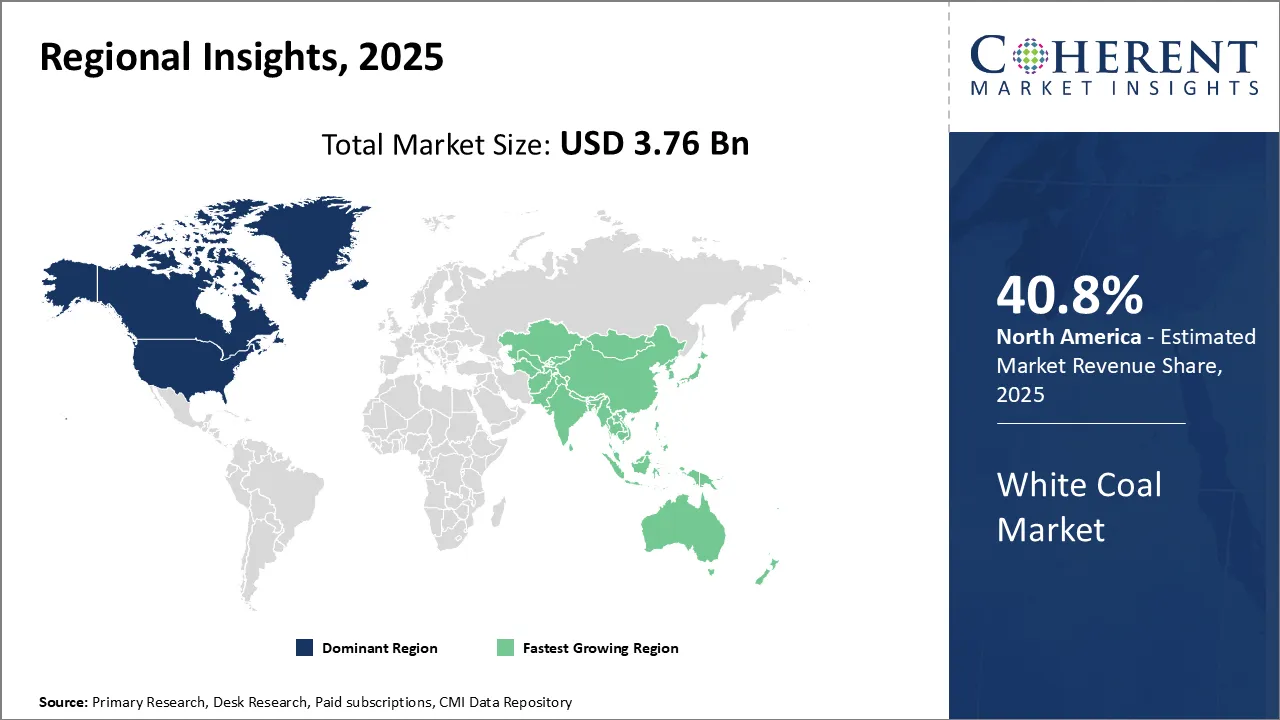White Coal Market Size and Trends
The White Coal Market is estimated to be valued at USD 3.76 Bn in 2025 and is expected to reach USD 6.40 Bn by 2032, exhibiting a compound annual growth rate (CAGR) of 7.9% from 2025 to 2032.

Discover market dynamics shaping the industry: Download Free Sample
The growing demand for renewable energy sources coupled with supportive government policies promoting the usage of white coal has been driving the growth of the market. Many countries have set ambitious targets to increase the share of renewable energy in their overall energy mix. This is expected to boost the deployment of white coal-based projects in coming years. Also, rapid technological advancements in areas such as concentrated solar power and floating solar installations have enabled the generation of solar power in a more efficient manner. This is expected to provide opportunities for further market expansion during the forecast period. However, high initial capital investments remain a major challenge for widespread adoption of white coal technologies.
Drivers of the Market:
Increasing investments in renewable energy sources
With growing concerns about climate change and rising carbon emissions, many governments and organizations are prioritizing investments in clean and renewable energy sources. Solar and wind energy in particular are receiving a significant boost globally as alternatives to fossil fuel-based power generation. The advantages of sunlight and wind as natural energy sources that do not pollute the environment make them attractive long-term options. Many nations have announced ambitious renewable energy targets and established production-linked incentive programs to encourage local manufacturing of photovoltaic panels, wind turbines, and other equipment. International commitments to reduce carbon footprints under the Paris Agreement have also accelerated renewable investments.
The white coal or hydropower sector has huge untapped potential in many parts of the world. Several developing economies are investing heavily in large and small hydropower projects to meet electricity demand as part of their renewable energy strategies. Hydropower presents a reliable renewable alternative for baseload power needs. Countries with abundant water resources are developing new dams, barrages, and run-of-the-river hydropower plants. Private entities too have shown renewed interest in funding hydro projects due to the stability and predictability they offer compared to other renewables. Governments in Asia, Latin America, and Africa in particular have announced plans to invest tens of billions of dollars in new hydro assets over the next decade. This bodes well for sustained demand growth in the global white coal market.
Market Concentration and Competitive Landscape

Get actionable strategies to beat competition: Download Free Sample
Advances in renewable energy technologies
While hydropower has been a mainstay of power generation for decades utilizing the potential energy of water, technological innovations now allow extracting more value from this renewable resource. New designs harness various river discharge patterns more efficiently through technologies like pulse flow hydropower stations and in-stream turbine systems integrated into existing water infrastructure. Storage capacity too is increasing with pumped hydro facilities that operate alongside conventional dams. Meanwhile, run-of-river schemes have become more viable with advances in low-head hydropower turbines optimized for variable flow conditions.
On the other hand, opportunities are emerging from non-conventional hydropower sources as well. Wave and tidal energy converters are maturing to tap the limitless power of ocean waves and tides, especially in coastal regions. Even developments in micro-hydropower technology have enabled decentralized off-grid solutions suitable for remote rural areas and islands.
Key Takeaways from Analyst:
The white coal market is witnessing significant growth globally driven by increasing demand for cleaner energy sources. Asia Pacific represents the fastest growing regional market attributable to strong economic development. China continues to dominate white coal consumption owing to ongoing industrialization and urbanization activities.
Power generation is expected to remain the leading application area given rising focus on reducing emissions. Meanwhile, potential environmental regulations especially in Europe may restrain market expansion to some extent. However, widespread acceptance of white coal as a transition fuel until viable renewable alternatives emerge is opening new opportunities. Additionally, technology advancements to facilitate cost-effective large-scale production and storage would further stimulate market potential. Conversely, availability of low-cost shale gas particularly in North America poses notable challenges.
Growing renewable integration is boosting the need for energy storage that white coal is well-positioned to fulfill. Furthermore, emerging economies ramping up infrastructure development and power capacities present an important growth avenue. Continuous research efforts to enhance efficiency and lower costs could also expand white coal applications beyond power generation in the long-run.
Market Challenges: High capital investment
The high capital investment required for adopting white coal technologies is one of the major bottlenecks restraining the growth of the white coal market. Switching to new energy sources demand heavy upfront capital expenses which are difficult for many utility providers and consumers to bear, especially in the current economic climate. Adopting white coal technologies involves installing new equipment and retrofitting existing infrastructure which has significant costs associated with it. For example, setting up solar farms requires procuring and installing thousands of solar panels, mounting structures, cables and other associated balance of system components. Similarly, implementing large scale wind power projects demands erecting wind turbines, transmission towers, substations etc., across vast stretches of land which is a costly undertaking. Even for commercial and residential properties, the initial capital required for a full scale retrofit with solar rooftop systems or small wind turbines can run into several thousand dollars.
Market Opportunities: Urbanization and industrialization in developing countries
Urbanization and industrialization in developing countries provide a huge opportunity for the white coal market to grow exponentially in the coming years. As more people migrate to cities for employment opportunities and a better standard of living, the urban population in countries like India, China, Nigeria, Brazil, etc. are rising rapidly.
Along with urbanization, ongoing industrialization is also contributing significantly to the growth of waste generation. Developing nations want to become manufacturing hubs and this is spurring new investments in sectors like automobiles, electronics, chemicals etc. The waste streams from these industries presents a major opportunity for waste-to-energy projects if harnessed scientifically. The Indian government has also recognized this potential of waste-to-energy through various schemes announced in recent Union Budgets.

Discover high revenue pocket segments and roadmap to it: Download Free Sample
Insights by product type : Driven by convenience and cost effectiveness
In terms of product type, the briquettes segment is expected to hold 45.0% share of the white coal market in 2025, owing to its convenience and cost effectiveness. Briquettes are compact logs or tablet-shaped fuels produced from ground or pulverized coal that have been compressed and formed into shapes that burn slowly similar to logs. This format makes briquettes very convenient for home heating as they can be easily transported and stored similar to firewood logs. However, briquettes have significantly higher energy density than raw coal or firewood of the same volume, making them more cost effective to use per unit of heat generated.
The convenience of briquette format combined with lower transportation and storage costs compared to loose coal dust or pellets has helped drive widespread adoption. The uniform shape and density of briquettes also ensures predictable and sustained burn times that can be reliably used for heating homes overnight or throughout the day. Many households prefer briquettes as they do not require specialized stoves meant for other coal products like pellets. The uniformity also eliminates issues like clumping or breakage common with loose coal powders.
Overall, briquettes have seen the most popularity and market share growth within the white coal segment due to offering the benefits of coal in an easy-to-use format that maximizes cost effectiveness. Their widespread availability from retail outlets also ensures reliability and accessibility for both urban and rural households relying on white coal for affordable home heating needs. While other formatted products like pellets are growing in popularity, briquettes versatility and convenience will likely continue dominating the white coal market.
Insights by End-Use : Reliance on Affordable Heating Fuels
In terms of end-Use , the residential sector contributes the 44.8% share in 2025. This can be attributed to the continued reliance of households on affordable heating fuels. Despite various initiatives to promote cleaner energy options, a significant percentage of the population still depends on cheaper fuel sources like coal for meeting their regular heating demands. The use of white coal for residential heating is concentrated in lower income neighborhoods and rural areas where access to pipelines supplying natural gas may be limited or unaffordable. For these households, briquettes and lump coal offer a readily available and inexpensive solution compared to electricity or LPG gas cylinders. Even a small switch to these cleaner alternatives would require upfront installation costs for new equipment that many low income families cannot afford.
Additionally, regions with longer or more extreme winters also see higher demand from residential users stocking up on coal supplies. The affordability and ease of stockpiling large inventories of white coal makes it a necessity for households in such climates to maintain consistent indoor heating through the colder months of the year.
Regional Insights

Need a Different Region or Segment? Download Free Sample
North America has emerged as the dominant regional market for white coal over the past decade. Driven by robust domestic demand from power producers, the size and maturity of the white coal mining industry in the U.S. and Canada has far outpaced other global markets. Major mining companies based in North America control over 40.8% share of global white coal reserves and are among the lowest cost producers in 2025. This strong competitive position has facilitated significant exports from the region to Asia and Europe. The development of large-scale transport infrastructure for white coal has further strengthened North America's hub status. Cities like Denver have become important trading centers for global white coal price benchmarking. The market leadership of North America also stems from the large-scale substitution of white coal for oil and natural gas power generation fuels over the past 20 years. Significant policy support through emissions regulations has motivated many utilities to transition older fuel plants. Combined with competitive mining costs, the use of white coal has increased markedly for both base load and peak power supply across many US states and Canadian provinces.
Among emerging markets, Asia Pacific is anticipated to witness the fastest growth for white coal in the coming years. Rapid industrialization and huge investments in new coal-fired capacities suggest an inelastic requirement for affordable fuel in the near future. While domestic reserves exist, extraction rates are insufficient to meet projected energy needs. This demand-supply gap will likely be met through increasing white coal imports, transforming South Asia into a key target market for global miners and traders. Early signs of this shift are already visible through the introduction of large port infrastructure to facilitate seaborne shipments into the region. Strong economic progression coupled with a young and growing population base highlights sustained potential for rising white coal consumption over the long run.
Market Report Scope
White Coal Market Report Coverage
| Report Coverage | Details | ||
|---|---|---|---|
| Base Year: | 2024 | Market Size in 2025: | USD 3.76 Bn |
| Historical Data for: | 2020 To 2024 | Forecast Period: | 2025 To 2032 |
| Forecast Period 2025 to 2032 CAGR: | 7.9% | 2032 Value Projection: | USD 6.40 Bn |
| Geographies covered: |
|
||
| Segments covered: |
|
||
| Companies covered: |
Hind Bio Coal, ETIA SAS, Airtex Energy, Torr Coal, SSGE Bio Energy Company Ltd, Global Bio-Coal Energy Inc., Vega Biofuels Inc., NextCoal International, Inc., CSC Bio-Coal Sdn. Bhd., Balaji Agro Coal Industries, Nexgen Energia, KKR Bio Fuels, BMK Woods, and VIGIDAS PACK |
||
| Growth Drivers: |
|
||
| Restraints & Challenges: |
|
||
Uncover macros and micros vetted on 75+ parameters: Get instant access to report
Market Segmentation
- Product Type Insights (Revenue, USD Bn, 2020 - 2032)
- Briquettes
- Pellets
- Lump
- End-use Insights (Revenue, USD Bn, 2020 - 2032)
- Residential
- Commercial
- Industrial
- Regional Insights (Revenue, USD Bn, 2020 - 2032)
- North America
- U.S.
- Canada
- Latin America
- Brazil
- Argentina
- Mexico
- Rest of Latin America
- Europe
- Germany
- U.K.
- Spain
- France
- Italy
- Russia
- Rest of Europe
- Asia Pacific
- China
- India
- Japan
- Australia
- South Korea
- ASEAN
- Rest of Asia Pacific
- Middle East & Africa
- GCC Countries
- Israel
- Rest of Middle East & Africa
- North America
- Key Players Insights
- Hind Bio Coal
- ETIA SAS
- Airtex Energy
- Torr Coal
- SSGE Bio Energy Company Ltd
- Global Bio-Coal Energy Inc.
- Vega Biofuels Inc.
- NextCoal International, Inc.
- CSC Bio-Coal Sdn. Bhd.
- Balaji Agro Coal Industries
- Nexgen Energia
- KKR Bio Fuels
- BMK Woods
- VIGIDAS PACK
Share
Share
About Author
Vidyesh Swar is a seasoned Consultant with a diverse background in market research and business consulting. With over 6 years of experience, Vidyesh has established a strong reputation for his proficiency in market estimations, supplier landscape analysis, and market share assessments for tailored research solution. Using his deep industry knowledge and analytical skills, he provides valuable insights and strategic recommendations, enabling clients to make informed decisions and navigate complex business landscapes.
Missing comfort of reading report in your local language? Find your preferred language :
Transform your Strategy with Exclusive Trending Reports :
Frequently Asked Questions
EXISTING CLIENTELE
Joining thousands of companies around the world committed to making the Excellent Business Solutions.
View All Our Clients
